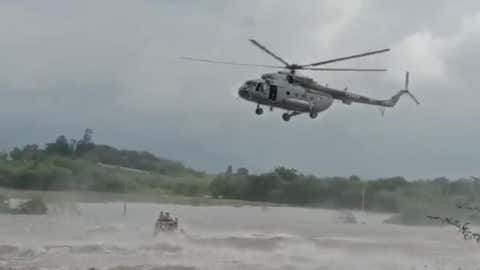[ad_1]

Some suspect the heavy rains creating floods in Telangana may be an “attack” by outside forces
(Ram Moorthy/TOI, BCCL, Hyderabad)
From 5G causing COVID-19 to bomb-testing behind the tsunami, India is no stranger to wild conspiracy theories strung around catastrophes. This week, Telangana CM K Chandrashekar Rao stoked controversy by referring to the possibility of a “foreign hand” causing the cloudburst events that caused floods in Kashmir, Ladakh, Uttarakhand, and over the swelling Godavari river.
While most experts discredited the theory saying that it’s a ruse to hide the unpreparedness of the state, some say that the claims are worth investigating. When it comes to weather, feeds on fear to reproduce and leads to unscientific beliefs. But not all conspiracy theories are baseless! For instance, the tobacco industry suppressing evidence of health impacts and the Phoebus cartel deliberately reducing the life span of light bulbs turned out to be valid to a certain extent.
Therefore, our premier research investigator, Science Sherlock, had to look into the matter!
Meddling with weather
While geoengineering to manipulate the weather is not new, its use is not widespread due to scientific uncertainty and limited success. However, amid the brewing climate crisis, this approach often gets traction among the scientific community and the general public alike. Yet, geoengineering or weather modification techniques remain embedded in controversy and speculations.
One of the most famous techniques is called “cloud-seeding”, where small particles of silver or lead iodide are dispersed via aircraft in the sky, which mix with water in the atmosphere to create “ice crystals”. These crystals fall due to their weight and eventually precipitate to form raindrops.

Some countries use “cloud-seeding” to induce artificial rains over a region
(Rajtilak Naik/BCCL – GOA)
The Americans actually carried out this tactic in the Vietnam War to prolong the monsoon in the country and flood rivers to their advantage in the infamous “Operation Popeye”. Shortly after, such techniques were promptly banned by the European Modification Convention.
Attempts in India
Even Indian states like Tamil Nadu, Karnataka, Andhra Pradesh and Maharashtra have attempted cloud-seeding to combat drought conditions during the late 20th and early 21st centuries. While the success rate varied, research in this domain has continued with the Pune-based Indian Institute of Tropical Meteorology (IITM) spearheading the seeding experiments for several years now.
“The microscopic cloud seeding experiments at IITM are aimed at drafting guidelines for such operations in future. We fly special aircraft into clouds to register information on how raindrops are formed, how pollution influences rain, what happens to clouds on seeding, whether rain reaches the surface, under what conditions cloud-seeding work, and so on. We have made some real progress in terms of understanding the ideal conditions for cloud seeding,” explained Dr Thara Prabhakaran, a scientist at IITM, in an earlier interview with weather.com.
China’s attempts to modify the weather
More recently, BBC alleged that China might have used weather modification in order to create ideal conditions for the 2008 Beijing Olympics, making rainfall before the competitions to ensure no disruptions took place during the event.
While over 50 countries have practised some form of cloud seeding for decades, China falls to controversy quite often in this regard due to the scale and intensity of their practice. Our Asian neighbour has reportedly carried out over half a million weather-modification operations between 2002 and 2012. In 2020, the country revealed that strides in their weather modification science would enable them to alter the weather of an area that could span a massive 5.5 million square kilometres — or 1.5 times the total size of India.

China allegedly used weather modification to create ideal conditions for the 2008 Beijing Olympics
(IANS)
Clearly, this sent many Indian alarm bells ringing as the two neighbouring countries have a well-recorded history of frequent clashes. So far, most of China’s weather modification practices have served as a purely domestic means to avoid agriculture and economic disruption.
Cross-border geoengineering
Many experts worry that such experiments might give China an edge in future conflicts, especially in regions of extreme weather such as the state border within the Himalayas.
“The emergence of ambitious geoengineering technologies could exacerbate tensions and even hostility between nations such as India and China. Without regulation, one country’s efforts could affect other countries,” states Dhanasree Jayaram, a climate expert from the Manipal Academy of Higher Education, in an opinion piece.
“While China has not yet shown signs of ‘unilaterally’ deploying geoengineering projects on the ground, the scale of its weather modification and other massive engineering projects… suggests China is willing to deploy large-scale geoengineering schemes to tackle the impacts of climate change.”
The jurisdiction among states diminishes very rapidly when we consider something intangible such as the air above physical land. With China aggressively trying to tame the weather above their country, some worry about the repercussions it might have on the neighbours.
Coming back to Telangana floods…
While these incidents took place eerily close to home, there is currently no proof that the same happened over Telangana in the recent Godavari flooding.

A swelling Godavari river led to the rescue operation of 70,000 residents
(IANS)
In fact, a panel of experts, including former Commissioner (RTI-A) Sri R Dileep Reddy and Environmentalist and Hydrology expert Sri. B. V. Subba Rao released a detailed report assessing the politicisation of the cloudburst phenomena and said the claim has no scientific evidence or validity. They explained that the state of La Niña in the Pacific Ocean led to excess rainfall and highlighted the need for more science-based public policy and disaster management plans in Telangana.
Read: Understand all about the Telangana cloudburst conspiracy
However, some scientists believe that the manner in which localised weather events have been behaving is too suspicious to be just a coincidence. Vineel Bhurke, an expert in Agriculture and Rural Management, alleges that unfavourable weather phenomena such as hailstorms, flash floods and cloudbursts have lined up splendidly with “critical” phases of crop growth leading to large economic losses. Citing our dependence on agriculture as an agrarian country, he posits that this could be the conscious work of an “unknown adversary”.
“Everyone is happily justifying the phenomena using climate change. This is quite disheartening! So much so that the possible ‘weaponisation of weather (WoW)’ phenomenon seems somewhat like a UFO theory to be ridiculed and neglected by the mainstream scientific community. However, WoW and its impact have been clearly visible in the past and have affected a large number of people, and hence needs to be taken seriously,” says Vineel.
Engineering the weather in the future
India has been enduring extreme climate change-induced weather conditions for the past few years, ranging from the hottest days recorded in our summers to the increasing devastation of recurring floods in our monsoons. This imposes a socio-economic tax whose weight has become excruciatingly hard for us to bear. If we were to add the ramifications of weather meddling into the mix, there is currently no way of knowing how this might affect the already disaster-struck residents in the future.
The lack of a system of checks on nations attempting this controversial method could also lead to unfair “rain stealing” by one country from the other, experts worry. To add to this, there is no way of telling normal rainfall in a region apart from the artificially induced one, which adds to the lack of accountability.

A type of geoengineering using space bubbles to reverse climate change
(MIT/Senseable City Labs)
However, there is no denying the economic advantages that this level of geoengineering can offer. According to a report by CNN, China spent $1.34 billion on weather modification programs over five years, which helped them reduce 70% of hail damage in key agricultural districts.
Other geoengineering alternatives include using silicon-based bubbles placed between the Earth and the Sun in space to reduce the incoming radiation from the star, which could mitigate some of the effects of global warming. It remains to be seen how far humanity goes to tackle the weather woes and if we can indeed strike a balance between the ethical implications of such experiments!
**
For weather, science, space, and COVID-19 updates on the go, download The Weather Channel App (on Android and iOS store). It’s free!
[ad_2]
Source link